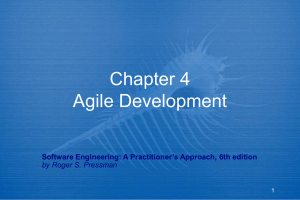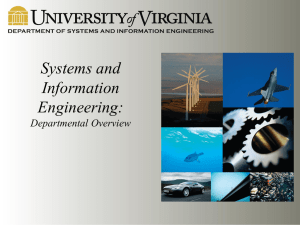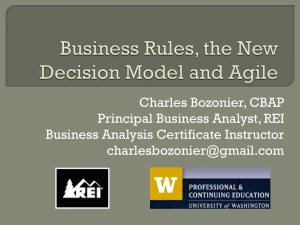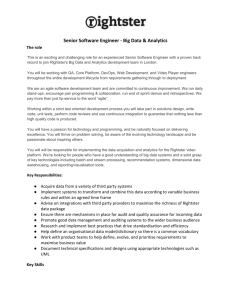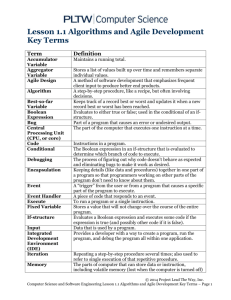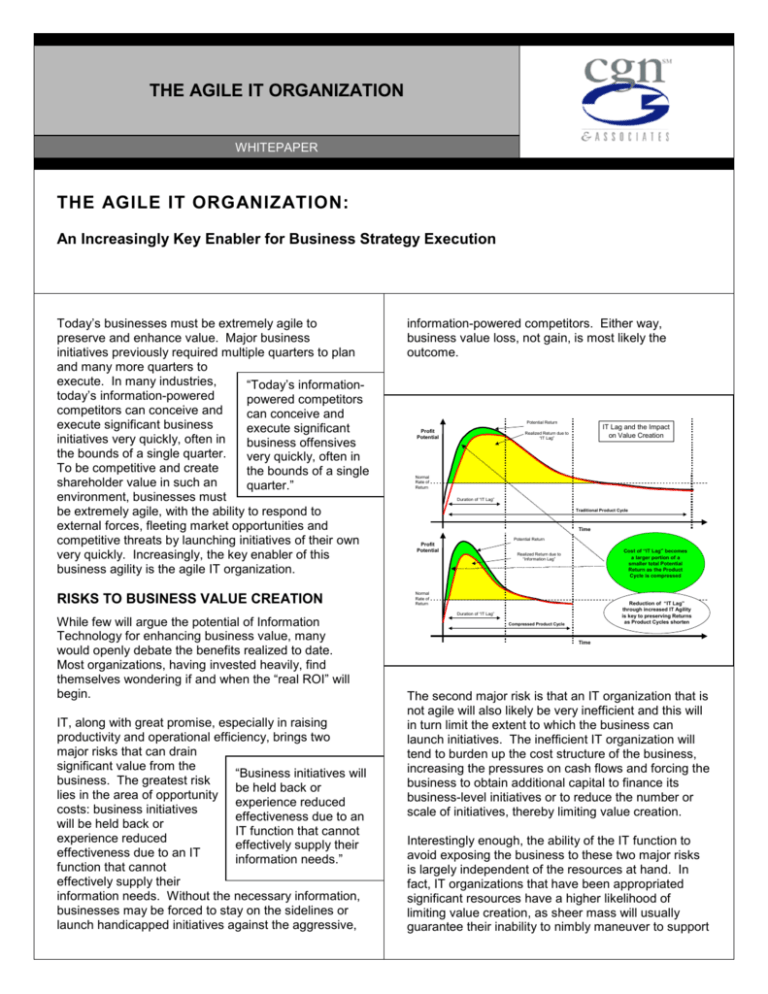
THE AGILE IT ORGANIZATION
WHITEPAPER
THE AGILE IT ORGANIZATION:
An Increasingly Key Enabler for Business Strategy Execution
Today’s businesses must be extremely agile to
preserve and enhance value. Major business
initiatives previously required multiple quarters to plan
and many more quarters to
execute. In many industries,
“Today’s informationtoday’s information-powered
powered competitors
competitors can conceive and
can conceive and
execute significant business
execute significant
initiatives very quickly, often in
business offensives
the bounds of a single quarter.
very quickly, often in
To be competitive and create
the bounds of a single
shareholder value in such an
quarter.”
environment, businesses must
be extremely agile, with the ability to respond to
external forces, fleeting market opportunities and
competitive threats by launching initiatives of their own
very quickly. Increasingly, the key enabler of this
business agility is the agile IT organization.
RISKS TO BUSINESS VALUE CREATION
information-powered competitors. Either way,
business value loss, not gain, is most likely the
outcome.
Potential Return
Profit
Potential
IT Lag and the Impact
on Value Creation
Realized Return due to
“IT Lag”
Normal
Rate of
Return
Duration of “IT Lag”
Traditional Product Cycle
Time
Potential Return
Profit
Potential
Cost of “IT Lag” becomes
a larger portion of a
smaller total Potential
Return as the Product
Cycle is compressed
Realized Return due to
“Information Lag”
Normal
Rate of
Return
Reduction of “IT Lag”
through increased IT Agility
is key to preserving Returns
as Product Cycles shorten
Duration of “IT Lag”
While few will argue the potential of Information
Technology for enhancing business value, many
would openly debate the benefits realized to date.
Most organizations, having invested heavily, find
themselves wondering if and when the “real ROI” will
begin.
IT, along with great promise, especially in raising
productivity and operational efficiency, brings two
major risks that can drain
significant value from the
“Business initiatives will
business. The greatest risk
be held back or
lies in the area of opportunity
experience reduced
costs: business initiatives
effectiveness due to an
will be held back or
IT function that cannot
experience reduced
effectively supply their
effectiveness due to an IT
information needs.”
function that cannot
effectively supply their
information needs. Without the necessary information,
businesses may be forced to stay on the sidelines or
launch handicapped initiatives against the aggressive,
Compressed Product Cycle
Time
The second major risk is that an IT organization that is
not agile will also likely be very inefficient and this will
in turn limit the extent to which the business can
launch initiatives. The inefficient IT organization will
tend to burden up the cost structure of the business,
increasing the pressures on cash flows and forcing the
business to obtain additional capital to finance its
business-level initiatives or to reduce the number or
scale of initiatives, thereby limiting value creation.
Interestingly enough, the ability of the IT function to
avoid exposing the business to these two major risks
is largely independent of the resources at hand. In
fact, IT organizations that have been appropriated
significant resources have a higher likelihood of
limiting value creation, as sheer mass will usually
guarantee their inability to nimbly maneuver to support
the information needs of
business initiatives and in
all but the rarest cases,
these well-endowed IT
organizations will be
extremely inefficient,
pressuring cash flows and
further limiting the
offensive maneuvers of
the business.
Up Cycle
Available
Capital
IT
Down Cycle
Available
Capital
IT
DEVELOPING AGILITY IN THE IT
ORGANIZATION
This paper outlines a set of enabling approaches,
required competencies and human capital that will
significantly increase the agility of the IT
organization.
This increased agility will equip the IT organization
to add tremendous value by quickly and effectively
supplying the information needs of business
initiatives and reducing the overall operating
leverage of the business.
“Due to our IT systems, we were not in competitive mode
in the 1990s. My job was to make sure IT never inhibited
the speed of GM again.”
Ralph Szygenda, Group VP and CIO - General Motors
InformationWeek, June 3, 2002
2
THE AGILE IT ORGANIZATION
A PROJECT-DRIVEN APPROACH
The first enabling approach provides a charter and an
infrastructure for IT to become a project-driven
organization. Every activity, every resource, every cost
is attributable to a project.
This project-driven approach
“In a project-driven IT
provides the key linkage to
organization, resources
drive alignment between
and functions exist only
business initiatives and IT
in the context of a
activities and allows for better
project, and the profile of
management, visibility and
the IT organization is
utilization of IT assets and
largely a function of the
expenditures. In addition, this
profile of the business at
structure and approach allows
any point in time.”
for IT costs to be properly
accounted for within business initiatives, giving a more
accurate picture of projected and actual rates of return
for the business initiatives. Many times, a business
initiative passes the hurdle rate in the capital budgeting
process and is approved only because the supporting IT
costs are not fully considered.
Especially within larger enterprises, IT organizations
lacking a project-driven approach tend to lapse into a
sluggish state, where IT departments or functional
groups just “exist”, continuing to serve some longexpired purpose which may be only vaguely refined year
after year.
In a project-driven IT organization, resources and
functions exist only in the context of a project, and the
profile of the IT organization is largely a function of the
profile of the business at any
point in time. The IT
“Many times, a business
organization’s project portfolio
initiative … is approved
will contain two types of
only because the
projects at any given time.
supporting IT costs are
There will be “offensive” IT
not fully considered.”
projects, wherein a business
initiative is launched and one
or more supporting IT projects is spawned to quickly and
effectively supply the information needs of that initiative.
There are also “sustaining” IT projects, which provide
basic infrastructure to be leveraged across many
projects and also provide maintenance and operations
support for previous initiatives. A project time tracking
system is an essential tool for establishing the projectdriven approach.
To accelerate the migration to a project-driven approach,
many organizations establish a Project Management
Office. In addition to instilling a project-driven approach,
an effective PMO can also increase maturity in the
processes of project management, a strategic
competence discussed below.
2002 CGN & Associates, Inc. All rights reserved. Printed in the U.S.A.
STRATEGIC IT COST MANAGEMENT
Strategic IT Cost Management
Business-Driven
Discretionary
In addition to a project-driven approach, the
adoption of a strategic cost management approach
for IT is a critical success factor in achieving agility.
The mix of fixed and variable costs within the IT cost
structure is an essential determinant of the degree
of agility that can be
attained. In addition, as an “By effectively managing
enterprise becomes more
the IT cost structure to
information-centric, ITinclude a strategic mix of
related costs will account
fixed and variable costs,
for a larger and larger
the overall operating
percentage of the overall
leverage of the firm can
cost structure of the
be better controlled and
enterprise. By effectively
overall business risk will
managing the IT cost
be reduced, especially
structure to include a
for firms with cyclical
strategic mix of fixed and
revenues.”
variable costs, the overall
operating leverage of the firm can be better
controlled and overall business risk will be reduced,
especially for firms with cyclical revenues.
As a result, the business will exhibit more
predictable performance as variable IT costs can be
quickly shed in response to
“Left undisturbed,
revenue troughs.
IT organizations
tend to evolve in
An IT organization that has high
fixed costs, usually dominated by the direction of
labor and infrastructure costs, will higher fixed
costs.”
be less flexible and will exhibit
less agility in support of business
initiatives. In addition, as IT organizations develop
larger fixed headcounts, a natural consequence is
that the human resources issues inherently involved
with permanent staff will begin to command more
and more attention, diverting focus and energies
from value enhancing activities.
Left undisturbed, IT organizations tend to evolve in
the direction of higher fixed costs. Over time, fixed
costs creep into the system and very seldom do they
creep out voluntarily. New
“Oftentimes,
headcount is added in
headcount and
support of an initiative, but
those headcount never leave substantial assets
cannot be easily
as the initiative runs its
traced back to their
course – they simply are
sponsoring initiatives.”
“absorbed” into the IT
organization and often take
on some marginally valuable role that they are often
marginally qualified to fulfill. The same
phenomenon applies to infrastructure costs as well.
New platforms and software packages are
purchased to support an initiative, but the
depreciation and operating expenses associated
3
THE AGILE IT ORGANIZATION
Fixed Operating
Managed Growth
in Overall IT Cost
Structure
Allocated back to
Business Programs
Increasing Support for Business Value Creation
Total
Variable
Costs
IT Cost
Structure
Prudent Application and
Infrastructure Enhancements
Strategic
Fixed Cost
Target
Initial
Rationalization of
Fixed Operating
Costs
Y1
Y2
Total
Fixed
Costs
Fine Tuning of Fixed
Operating Costs
Y3
Y4
Y5
Time
with these new assets remain on the books long after
the initiative is distant memory. Oftentimes, headcount
and substantial assets cannot be easily traced back to
their sponsoring initiatives.
Under the strategic IT cost management approach, a
target cost structure is established based on a variety of
environmental variables and the current and projected
project portfolios. This target cost structure effectively
supports the project portfolio while minimizing fixed, or
“sustaining”, costs. As each environment is unique,
there is no hard guideline for a target ratio of fixed and
variable costs. It is often most effective to establish a
series of incremental targets that allow the ratio of fixed
costs to be systematically reduced to a target level over
a period of time.
REQUIRED COMPETENCIES FOR IT AGILITY
In addition to establishing the project-driven and
strategic cost management approaches, the agile IT
organization must develop certain core competencies to
remain agile in supporting a changing business
environment.
2002 CGN & Associates, Inc. All rights reserved. Printed in the U.S.A.
STRATEGIC ALIGNMENT
TECHNICAL ARCHITECTURE
The first required competency, strategic alignment, is the
ability to effectively establish
and continuously align a
supporting technology strategy “The business and
technology strategies
to the business strategy. The
must be fully reinforcing
business and technology
at all times. Any change
strategies must be fully
in the business strategy
reinforcing at all times. Any
must be quickly and
change in the business
appropriately reflected in
strategy must be quickly and
the technology strategy.”
appropriately reflected in the
technology strategy.
This competency must be reflected in the abilities of the
CIO and other IT leadership. The CIO must have the
business acumen to assess the steps required to realign
the strategies and must have the leadership skills to
drive the IT organization (and the greater organization)
in effectively and quickly executing the necessary course
changes.
Vision
Mission
Values
Objectives
Profile
business inputs and
organizational profile
Product/
Service
Offerings
Suppliers
Positioning
business outputs and
market positioning
Internal
Organization
Competitive
Scope
Business
Partners
Competitive
Position
Distribution
Channels
Business
Architecture
Captures the Profile and Positioning
and resulting CSFs for the organization
Information
Architecture
Maps the core intra and inter-company
business processes and information flow
necessary to achieve the CSFs
CSFs
Physical
Assets
Customer
Base
Planning and
Adminis tr atio n
Value Chain
Processes
Supply
Value- Add
Demand
Operational Processes
Platforms
Management and Staffing
Utilities/Foundations
Data Stores
Custom
ERP
CRM
Productivity/
Collaboration
Applications
SCM
business processes and
information flows
Technology
Architecture
Defines the technology components,
operational processes and
organization necessary to “power”
the Information Architecture and
achieve the CSFs
The technical architecture is the foundation on which
new applications are deployed to support the
information requirements of business initiatives.
This foundation is a complex mix of communications
technologies, operating systems and hardware
platforms, data stores,
middleware/EAI tools and
“The technical
centralized and distributed
architecture is the
applications. The competence
foundation on which
to effectively manage this
new applications are
foundation is a major enabler
deployed to support
of IT agility. This competence
business initiatives.”
requires strict discipline in
documentation and the
establishment of technology standards and
operating processes and policies.
In addition to effectively managing the foundation
today, the IT organization
“Technologies such
must continually monitor the
as Web Services
emergence of new standards
and event-driven
and products that have the
infrastructures
potential to increase
promise substantial
flexibility and performance or
efficiencies and new
substantially decrease the
capabilities.”
operating expenses of the
technical architecture in the
future. Technologies such as Web Services and
event-driven infrastructures promise substantial
efficiencies and new capabilities. The IT
organization must proactively prepare the greater
organization to gain the benefits of these
developments.
IT
Agenda
Data Stores
Platforms
IT
Projects
Management and Staffing
Business
Programs
Operational Processes
Utilities/Foundations
Custom
Productivity/
Collaboration
CRM
Applications
ERP
Enterprise
Agenda
SCM
Communications
Communications
IT Resources and Assets
4
THE AGILE IT ORGANIZATION
2002 CGN & Associates, Inc. All rights reserved. Printed in the U.S.A.
PROJECT MANAGMENT
Due to the high failure rates of IT initiatives over the last
decade, project management competence is finally
being recognized as a leading determinant of success or
failure. Whether completely insourced or partially
outsourced, strong project management competence is
required to achieve agility and
consistently drive intended
“Whether completely
business value from IT
insourced or partially
initiatives.
outsourced, strong
project management
Project management
competency includes the ability competence is required
to consistently drive
to effectively partition a major
intended business value
initiative into phases and
from IT initiatives.”
manage concurrent execution.
By partitioning a major initiative
into phases, business value can be maximized, as the
highest value features will be implemented in the initial
phase and remaining features can be implemented in
value-priority order over time. In addition, by partitioning
an initiative, all inherent risks (e.g. changing business
requirements, technology risk, vendor risk, etc.) can be
more effectively managed.
OUTSOURCING MANAGMENT
To maximize responsiveness while maintaining the
target cost structure, the agile IT organization will
tactically leverage external resources. A project-driven
approach, project management competence, and a solid
technical architecture set the stage for effective tactical
outsourcing. The competency to
effectively establish and manage
“A project-driven
outsourcing arrangements
approach, project
through the full lifecycle is a key
management
determinant of agility.
competence, and a
solid technical
The ability to quickly develop
architecture set the
detailed requirements
stage for effective
specifications that clearly define
tactical outsourcing.”
functional, technical and
operating requirements is
essential in driving the procurement of outsourced
services. Without this ability, the outsourcing experience
will be contentious as gaps in expectations on a variety
of issues will surface and the intended value will not be
realized.
compensation structures, payment schedules, and
other terms and conditions are all key to productive
outsourcing relationships.
During the execution phase, the outsourcing
relationship must be constantly managed to
ensure adherence to the
“As tactical work is
contractual terms of the
increasingly shifted
arrangement and to
effectively deal with changes offshore, the added
logistical and cultural
to the arrangement as they
complexities make
become necessary. Many
effective management
properly structured
during the execution
outsourcing relationships fail
phase even more
due to a lack of diligence
critical.”
during the execution phase.
As tactical work is
increasingly shifted offshore, the added logistical
and cultural complexities make effective
management during the execution phase even more
critical.
As most of the best practices in procurement and
outsourcing of other core business functions are
equally applicable (e.g. supplier certification), the IT
organization can often leverage the overall
organizational competencies.
IT Salary Comparison
Country
Base Annual Salary (US$)
China
$4,750
India
$5,850
Philippines
$6,550
Russia
$7,500
Indonesia
$12,200
Japan
$44,000
United States
$63,000
SOURCE: ABERDEEN GROUP, NOVEMBER 2001
Outsourcing is by definition a contractual relationship
and that relationship must be diligently structured to
ensure that the desired benefits for both parties are
achieved with minimal friction. Clear and effective
definitions of scope of services to be provided, service
level agreements, vendor-customer interface protocol,
expected deliverables, change control mechanisms,
5
THE AGILE IT ORGANIZATION
2002 CGN & Associates, Inc. All rights reserved. Printed in the U.S.A.
HUMAN CAPITAL REQUIRED FOR AGILITY
With a focus on flexibility and strategic cost
management, the agile IT organization will have far
fewer permanent staff members, but these staff
members will be more experienced, more educated and
more business-oriented. The permanent staff will be
required to be less technical and
task-oriented and much more
“The agile IT
focused on driving business
organization will have
results through technology
far fewer permanent
alignment, execution and risk
staff members, but
management. The agile IT
these staff members
organization must have a
will be more
supporting human resources
experienced, more
strategy to ensure that these
educated and more
individuals are effectively
business-oriented.”
attracted, retained and
developed.
Also, the agile IT organization, by design, will be
comprised of high performers with high potential and
the IT leadership must be able to effectively manage
and coach these strong personalities to deliver
results.
AGILE IT: THE RESULTS
By adopting the enabling approaches, developing
the required competencies, and developing and
maintaining the proper human capital, an IT
organization will significantly increase its degree of
agility. The resulting organization will be markedly
different, as will the results. The agile IT
organization will be far smaller, far more efficient
and far more responsive in supporting the
information needs of the business at a lower fixed
cost, allowing the business to bolster its
competitiveness against increasingly aggressive,
information-powered competitors.
In line with their higher qualifications, the total potential
compensation required to attract and retain the
permanent staff will be higher on average. These
individuals are of the type sought after by traditional
management and technology consultancies and their
total potential compensation will need to be competitive,
all factors taken into consideration. Total potential
compensation should be a mix of salary and incentive
compensation, with senior staff also entitled to stock
options or other equity participation mechanisms.
Incentive compensation and the degree of equity
participation should be driven by performance against
personal, IT and overall business objectives.
In addition to effective compensation programs,
retaining these individuals will require the establishment
of effective career paths. As these individuals will be
both technology and business-savvy, their aspirations
will often take them beyond the bounds of the IT
organization. The greater
organization should recognize
“The greater
that these business-focused
organization should
technology professionals likely
recognize that these
represent the next generation
business-focused
of business leaders and that
technology professionals
effective mechanisms to
likely represent the next
promote their broader
generation of business
development must be
leaders.”
established.
To be effective, the agile IT organization must obviously
have strong leadership. The drive towards IT agility
itself can be very traumatic for the organization as
comfort zones are breached and status quos are
discarded. A strong leader is required to guide the
organization through this process, a process that will
cross all functional areas of the business.
6
THE AGILE IT ORGANIZATION
2002 CGN & Associates, Inc. All rights reserved. Printed in the U.S.A.
ABOUT THE AUTHOR
WORKING WITH US
John M. Damgaard is currently Vice President of
Operations and Principal with CGN and Associates, Inc.,
a Professional Services firm focused on providing
strategic guidance and technology solutions to the
world’s most admired companies.
Our simple objective is to become an invaluable
thinking partner for our customers, providing them
with strategic guidance and technology expertise to
allow them to be agile in responding to their everchanging business environment.
Prior to joining CGN, Mr. Damgaard held various
technical and management positions within Maytag
Corporation, leading its transition to a standards-based
technology infrastructure. During his tenure at IBM, Mr.
Damgaard participated in the development of the awardwinning OS/400 operating system at the Rochester, MN
facility, winner of the Malcom-Baldridge National Quality
Award.
As trusted advisor and partner to some of the
world’s most admired companies, we have gained a
wealth of experience and insight and continue to
earn the respect and business of our customers
through our value-driven approach.
Mr. Damgaard holds Bachelor’s degrees in Computer
Science and Mathematics and a Master’s degree in
Business Administration.
TO LEARN MORE
If you would like to hear our thoughts on a challenge
or opportunity you are facing or on a specific topic of
interest to you, please contact us at 1-888-RINGCGN or visit us at www.cgn.net.
th
One Lincoln Centre – 15 Floor
18W140 Butterfield Road
Oakbrook Terrace, IL 60181
888-RING-CGN
www.cgn.net
7
THE AGILE IT ORGANIZATION
2002 CGN & Associates, Inc. All rights reserved. Printed in the U.S.A.

